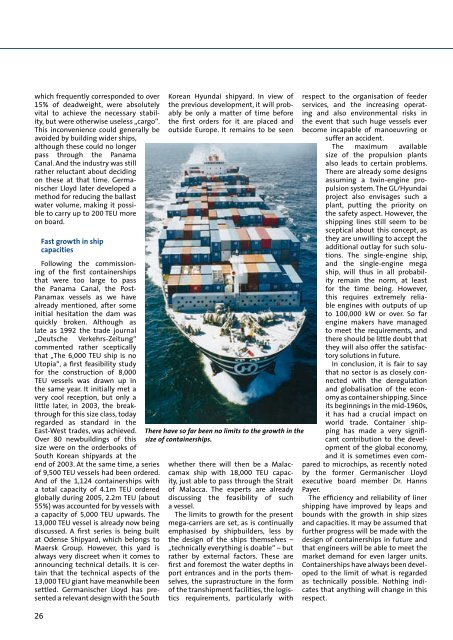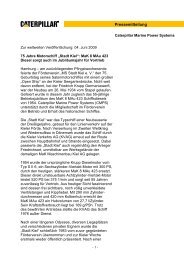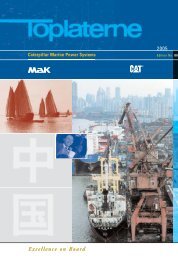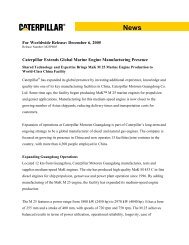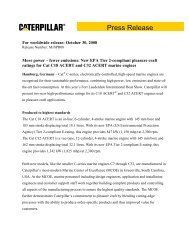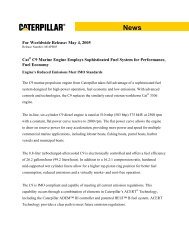Caterpillar Marine - Marine Engines Caterpillar
Caterpillar Marine - Marine Engines Caterpillar
Caterpillar Marine - Marine Engines Caterpillar
Create successful ePaper yourself
Turn your PDF publications into a flip-book with our unique Google optimized e-Paper software.
which frequently corresponded to over<br />
15% of deadweight, were absolutely<br />
vital to achieve the necessary stability,<br />
but were otherwise useless „cargo“.<br />
This inconvenience could generally be<br />
avoided by building wider ships,<br />
although these could no longer<br />
pass through the Panama<br />
Canal. And the industry was still<br />
rather reluctant about deciding<br />
on these at that time. Germanischer<br />
Lloyd later developed a<br />
method for reducing the ballast<br />
water volume, making it possible<br />
to carry up to 200 TEU more<br />
on board.<br />
Fast growth in ship<br />
capacities<br />
Following the commissioning<br />
of the first containerships<br />
that were too large to pass<br />
the Panama Canal, the Post-<br />
Panamax vessels as we have<br />
already mentioned, after some<br />
initial hesitation the dam was<br />
quickly broken. Although as<br />
late as 1992 the trade journal<br />
„Deutsche Verkehrs-Zeitung“<br />
commented rather sceptically<br />
that „The 6,000 TEU ship is no<br />
Utopia“, a first feasibility study<br />
for the construction of 8,000<br />
TEU vessels was drawn up in<br />
the same year. It initially met a<br />
very cool reception, but only a<br />
little later, in 2003, the breakthrough<br />
for this size class, today<br />
regarded as standard in the<br />
East-West trades, was achieved.<br />
Over 80 newbuildings of this<br />
size were on the orderbooks of<br />
South Korean shipyards at the<br />
end of 2003. At the same time, a series<br />
of 9,500 TEU vessels had been ordered.<br />
And of the 1,124 containerships with<br />
a total capacity of 4.1m TEU ordered<br />
globally during 2005, 2.2m TEU (about<br />
55%) was accounted for by vessels with<br />
a capacity of 5,000 TEU upwards. The<br />
13,000 TEU vessel is already now being<br />
discussed. A first series is being built<br />
at Odense Shipyard, which belongs to<br />
Maersk Group. However, this yard is<br />
always very discreet when it comes to<br />
announcing technical details. It is certain<br />
that the technical aspects of the<br />
13,000 TEU giant have meanwhile been<br />
settled. Germanischer Lloyd has presented<br />
a relevant design with the South<br />
26<br />
Korean Hyundai shipyard. In view of<br />
the previous development, it will probably<br />
be only a matter of time before<br />
the first orders for it are placed and<br />
outside Europe. It remains to be seen<br />
There have so far been no limits to the growth in the<br />
size of containerships.<br />
whether there will then be a Malaccamax<br />
ship with 18,000 TEU capacity,<br />
just able to pass through the Strait<br />
of Malacca. The experts are already<br />
discussing the feasibility of such<br />
a vessel.<br />
The limits to growth for the present<br />
mega-carriers are set, as is continually<br />
emphasised by shipbuilders, less by<br />
the design of the ships themselves –<br />
„technically everything is doable“ – but<br />
rather by external factors. These are<br />
first and foremost the water depths in<br />
port entrances and in the ports themselves,<br />
the suprastructure in the form<br />
of the transhipment facilities, the logistics<br />
requirements, particularly with<br />
respect to the organisation of feeder<br />
services, and the increasing operating<br />
and also environmental risks in<br />
the event that such huge vessels ever<br />
become incapable of manoeuvring or<br />
suffer an accident.<br />
The maximum available<br />
size of the propulsion plants<br />
also leads to certain problems.<br />
There are already some designs<br />
assuming a twin-engine propulsion<br />
system. The GL/Hyundai<br />
project also envisages such a<br />
plant, putting the priority on<br />
the safety aspect. However, the<br />
shipping lines still seem to be<br />
sceptical about this concept, as<br />
they are unwilling to accept the<br />
additional outlay for such solutions.<br />
The single-engine ship,<br />
and the single-engine mega<br />
ship, will thus in all probability<br />
remain the norm, at least<br />
for the time being. However,<br />
this requires extremely reliable<br />
engines with outputs of up<br />
to 100,000 kW or over. So far<br />
engine makers have managed<br />
to meet the requirements, and<br />
there should be little doubt that<br />
they will also offer the satisfactory<br />
solutions in future.<br />
In conclusion, it is fair to say<br />
that no sector is as closely connected<br />
with the deregulation<br />
and globalisation of the economy<br />
as container shipping. Since<br />
its beginnings in the mid-1960s,<br />
it has had a crucial impact on<br />
world trade. Container shipping<br />
has made a very significant<br />
contribution to the development<br />
of the global economy,<br />
and it is sometimes even compared<br />
to microchips, as recently noted<br />
by the former Germanischer Lloyd<br />
executive board member Dr. Hanns<br />
Payer.<br />
The efficiency and reliability of liner<br />
shipping have improved by leaps and<br />
bounds with the growth in ship sizes<br />
and capacities. It may be assumed that<br />
further progress will be made with the<br />
design of containerships in future and<br />
that engineers will be able to meet the<br />
market demand for even larger units.<br />
Containerships have always been developed<br />
to the limit of what is regarded<br />
as technically possible. Nothing indicates<br />
that anything will change in this<br />
respect.


